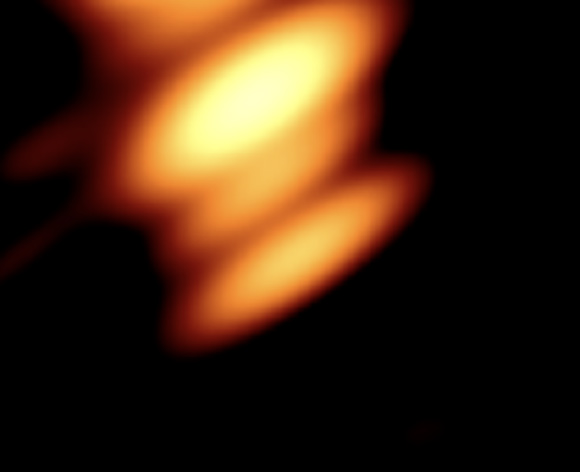Using data from the RadioAstron satellite, astronomers have produced a radio image of two supermassive black holes at the center of the distant quasar OJ 287, where the secondary black hole is in a 12-year orbit around the primary.

This RadioAstron map two supermassive black holes at the center of OJ 287, a galaxy located about 5 billion light-years away in the constellation of Cancer: if the central component corresponds to the primary black hole, then the next one upwards marks the secondary black hole, and the highest component represents a knot in its jet; the elongation of the individual components is not real, but is a reflection of the beam shape. Image credit: Valtonen et al., doi: 10.3847/1538-4357/ae057e.
Quasars are extremely bright galactic cores, whose light is produced when a supermassive black hole at the center of the galaxy devours the cosmic gas and dust around it.
In the past, astronomers have managed to image the black hole in the center of the Milky Way and in a nearby galaxy called Messier 87.
“Quasar OJ 287 is so bright that it can be detected even by amateur astronomers with private telescopes,” said Dr. Mauri Valtonen, an astronomer at the University of Turku.
“What is special about OJ 287 is that it has been thought to harbor not one but two black holes circling each other in a 12-year orbit, which produces an easily recognizable pattern of light variations in the same period.”
“The earliest observations of OJ 287 can be traced through old photographs all the way to the 19th century.”
“Back then, however, it was inconceivable that black holes existed, let alone quasars.”
“OJ 287 was ‘accidentally’ included in pictures while astronomers focused on other objects.”
As early as 1982, Dr. Valtonen noticed that the brightness of the object changed regularly over a 12-year period.
He went on to study OJ 287 as a university researcher, assuming that the brightness variation was caused by two black holes orbiting each other.
Hundreds of astronomers have been intensively monitoring the quasar to see if the theory is correct and to get a complete picture of the black holes’ orbital motion.
The mystery of the orbit was finally solved four years ago by University of Turku astronomer Lankeswar Dey.
The only question that remained was whether both black holes could be detected at the same time.
It was answered by NASA’s TESS satellite that detected light from both black holes.
However, they were still only visible as a single dot, because images using normal light do not have high enough resolution to show the black holes separately.
What was needed was an image with 100,000 times higher resolution, which is possible with radio telescopes.
In the current study, Dr. Valtonen and colleagues compared the earlier theoretical calculations with a radio image.
The two black holes were there in the image, just where they were expected to be.
This gave the researchers an answer to a question that has been open for 40 years: whether black-hole pairs exist in the first place.
“For the first time, we managed to get an image of two black holes circling each other,” Dr. Valtonen said.
“In the image, the black holes are identified by the intense particle jets they emit.”
“The black holes themselves are perfectly black, but they can be detected by these particle jets or by the glowing gas surrounding the hole.”
The scientists also identified a completely new kind of a jet emanating from a black hole.
The jet coming out of the secondary black hole in OJ 287 is twisted like a jet of a rotating garden hose.
“This is because the smaller black hole moves fast around the primary black hole, and its jet is diverted depending on its current motion,” the authors said.
Their paper was published in the Astrophysical Journal.
_____
Mauri J. Valtonen et al. 2025. Identifying the Secondary Jet in the RadioAstron Image of OJ 287. ApJ 992, 110; doi: 10.3847/1538-4357/ae057e







